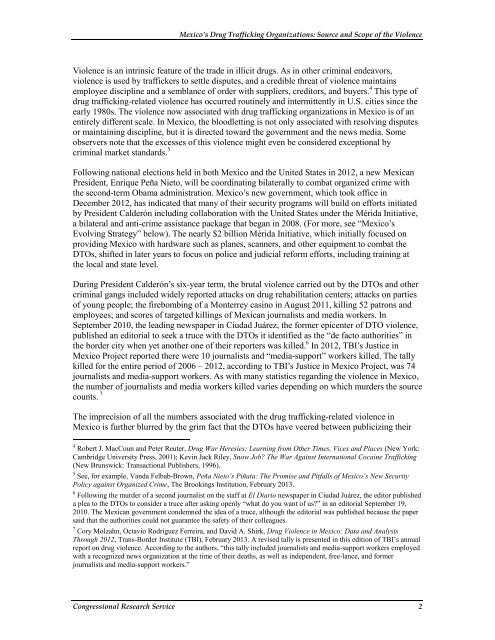Mexico's Drug Trafficking Organizations - Federation of American ...
Mexico's Drug Trafficking Organizations - Federation of American ...
Mexico's Drug Trafficking Organizations - Federation of American ...
Create successful ePaper yourself
Turn your PDF publications into a flip-book with our unique Google optimized e-Paper software.
Mexico’s <strong>Drug</strong> <strong>Trafficking</strong> <strong>Organizations</strong>: Source and Scope <strong>of</strong> the Violence<br />
Violence is an intrinsic feature <strong>of</strong> the trade in illicit drugs. As in other criminal endeavors,<br />
violence is used by traffickers to settle disputes, and a credible threat <strong>of</strong> violence maintains<br />
employee discipline and a semblance <strong>of</strong> order with suppliers, creditors, and buyers. 4 This type <strong>of</strong><br />
drug trafficking-related violence has occurred routinely and intermittently in U.S. cities since the<br />
early 1980s. The violence now associated with drug trafficking organizations in Mexico is <strong>of</strong> an<br />
entirely different scale. In Mexico, the bloodletting is not only associated with resolving disputes<br />
or maintaining discipline, but it is directed toward the government and the news media. Some<br />
observers note that the excesses <strong>of</strong> this violence might even be considered exceptional by<br />
criminal market standards. 5<br />
Following national elections held in both Mexico and the United States in 2012, a new Mexican<br />
President, Enrique Peña Nieto, will be coordinating bilaterally to combat organized crime with<br />
the second-term Obama administration. Mexico’s new government, which took <strong>of</strong>fice in<br />
December 2012, has indicated that many <strong>of</strong> their security programs will build on efforts initiated<br />
by President Calderón including collaboration with the United States under the Mérida Initiative,<br />
a bilateral and anti-crime assistance package that began in 2008. (For more, see “Mexico’s<br />
Evolving Strategy” below). The nearly $2 billion Mérida Initiative, which initially focused on<br />
providing Mexico with hardware such as planes, scanners, and other equipment to combat the<br />
DTOs, shifted in later years to focus on police and judicial reform efforts, including training at<br />
the local and state level.<br />
During President Calderón’s six-year term, the brutal violence carried out by the DTOs and other<br />
criminal gangs included widely reported attacks on drug rehabilitation centers; attacks on parties<br />
<strong>of</strong> young people; the firebombing <strong>of</strong> a Monterrey casino in August 2011, killing 52 patrons and<br />
employees; and scores <strong>of</strong> targeted killings <strong>of</strong> Mexican journalists and media workers. In<br />
September 2010, the leading newspaper in Ciudad Juárez, the former epicenter <strong>of</strong> DTO violence,<br />
published an editorial to seek a truce with the DTOs it identified as the “de facto authorities” in<br />
the border city when yet another one <strong>of</strong> their reporters was killed. 6 In 2012, TBI’s Justice in<br />
Mexico Project reported there were 10 journalists and “media-support” workers killed. The tally<br />
killed for the entire period <strong>of</strong> 2006 – 2012, according to TBI’s Justice in Mexico Project, was 74<br />
journalists and media-support workers. As with many statistics regarding the violence in Mexico,<br />
the number <strong>of</strong> journalists and media workers killed varies depending on which murders the source<br />
counts. 7<br />
The imprecision <strong>of</strong> all the numbers associated with the drug trafficking-related violence in<br />
Mexico is further blurred by the grim fact that the DTOs have veered between publicizing their<br />
4 Robert J. MacCoun and Peter Reuter, <strong>Drug</strong> War Heresies: Learning from Other Times, Vices and Places (New York:<br />
Cambridge University Press, 2001); Kevin Jack Riley, Snow Job? The War Against International Cocaine <strong>Trafficking</strong><br />
(New Brunswick: Transactional Publishers, 1996).<br />
5 See, for example, Vanda Felbab-Brown, Peña Nieto’s Piñata: The Promise and Pitfalls <strong>of</strong> Mexico’s New Security<br />
Policy against Organized Crime, The Brookings Institution, February 2013.<br />
6 Following the murder <strong>of</strong> a second journalist on the staff at El Diario newspaper in Ciudad Juárez, the editor published<br />
a plea to the DTOs to consider a truce after asking openly “what do you want <strong>of</strong> us?” in an editorial September 19,<br />
2010. The Mexican government condemned the idea <strong>of</strong> a truce, although the editorial was published because the paper<br />
said that the authorities could not guarantee the safety <strong>of</strong> their colleagues.<br />
7 Cory Molzahn, Octavio Rodriguez Ferreira, and David A. Shirk, <strong>Drug</strong> Violence in Mexico: Data and Analysis<br />
Through 2012, Trans-Border Institute (TBI), February 2013. A revised tally is presented in this edition <strong>of</strong> TBI’s annual<br />
report on drug violence. According to the authors, “this tally included journalists and media-support workers employed<br />
with a recognized news organization at the time <strong>of</strong> their deaths, as well as independent, free-lance, and former<br />
journalists and media-support workers.”<br />
Congressional Research Service 2















